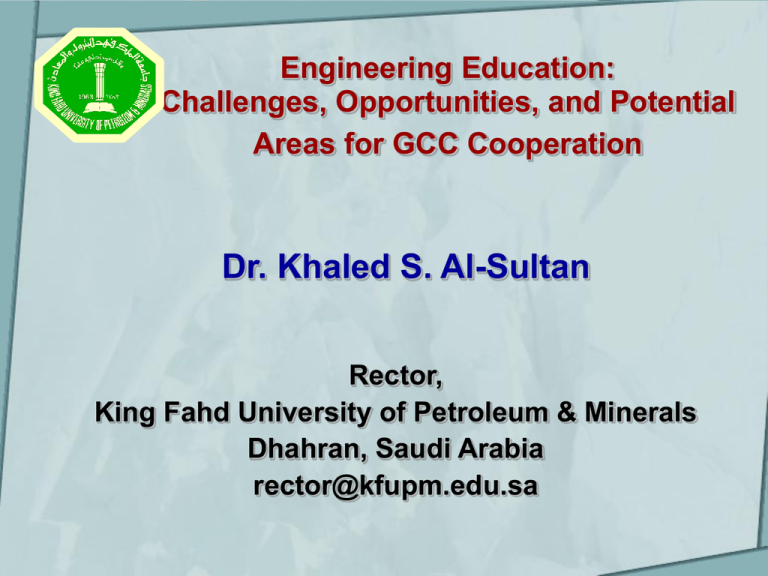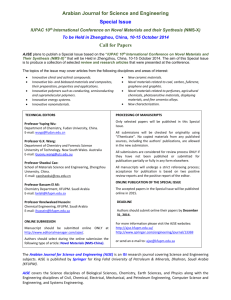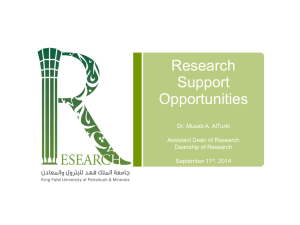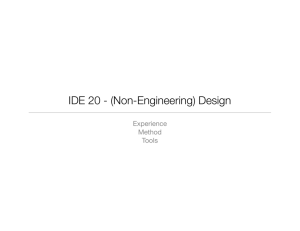the Presentation - Dr. Khaled S. Al
advertisement

Engineering Education: Challenges, Opportunities, and Potential Areas for GCC Cooperation Dr. Khaled S. Al-Sultan Rector, King Fahd University of Petroleum & Minerals Dhahran, Saudi Arabia rector@kfupm.edu.sa Outline Historical Overview of Engineering Education The Future of Engineering Education: Challenges and Opportunities Engineering Education in KSA KFUPM and Current Trends in Engineering Education Opportunities for cooperation within GCC Concluding Remarks 2 History of Engineering Education From prehistoric times, engineers have always led humanity for a better life. Till 1800s, engineering education was learned by apprenticeship (emphasis on hands-on experience). After 1800s, universities and colleges in Europe and US, started granting formal engineering degrees. 3 History of Engineering Education (cont…) In 1870, there were 17 universities teaching engineering in the US, growing to 110 schools in 1890. During same period, only 10% of practicing engineers were college graduates. End of 1800s, professional engineering societies started to flourish Early 1900s, laws governing licensing & certifications are introduced 4 History of Engineering Education (cont…) In 1932, ABET established: The beginning of an era of accreditation. 1950-1990, focus on engineering sciences, analysis, faculty expected to carry research After 1990 - now, focus on teamwork, communications, integration, design, continuous improvement, while maintaining analytical skills. 5 Features of Traditional Engineering Education More focused on abstract themes Instructor centered learning Depth in specialized fields Very little use of computers, Multimedia, Internet More focused on individual efforts 6 The Reality! Current Weaknesses in Today’s Eng. Graduates Weakness in understanding manufacturing processes Mostly analysts in specific areas Narrow view of engineering No understanding of quality process Weak communication skills Lack of design capabilities Weak teamwork & project management skills 7 Forces Pushing for Change Companies employing engineering graduates Accreditation boards (such as ABET) Globalization of economy Engineering professional societies Advisory boards 8 Future Technological Challenges of the 21st Century Main Features Information: Proliferation Tech. development: Multidisciplinary Markets: Globalized Environment: Endangered Social responsibility: Engineering Corporate structure: Participatory Change: Rapid! 9 The Ideal! 21st Century Engineering Skills Essential for Competitive Graduates: Strong technical capability Skills in communication and persuasion Ability to lead and work effectively as a member of a team Understanding of the non-technical forces that profoundly influence engineering decisions Commitment to lifelong learning Skills in design and project management Multidisciplinary 10 Quality Control for Engineering Programs Educational quality control is the cornerstone for successful engineering program Such quality control takes place through accreditation Accreditation reflects a professional judgment that certain students are met Acts as a benchmark for quality Accreditation is usually voluntary and conducted by peers 11 Main Features of Successful Engineering Education Programs for the Next Decade Students Faculty Infrastructure 12 Students Attract the best students in physical & mathematical sciences with leadership potential Educate & motivate engineering students to be ready: to implement new technology to focus on innovation to understand global trends 13 Faculty Select faculty with top engineering background Select faculty with excellent potential in carrying innovative research and providing leadership with a global look Select faculty committed to a dynamic teaching environment Provide faculty with opportunities for self development Facilitate cooperation with industry & the society at large 14 Infrastructure & Support Conducive environment that encourages high levels of productivity Up to date facilities of international standards Adopt flexible and clear rules and regulations 15 Engineering Education in the GCC 16 Engineering Programs First Engineering Colleges established in early 1960s Country Initially, 10 universities offered engineering programs No. Eng. St. (2005) KSA 14,000 Qatar 1,000 Kuwait 2,500 Bahrain 1,800 UAE 3,800 Oman 1,600 By 2005, more than 30 colleges/universities offered engineering programs There is an increase in the number of private colleges/universities New alliances with overseas universities were formed. Still, Number of engineering students per capita is still very low compared to developed countries 17 First university degrees, by region: 1997 and 2002 18 NS&E degrees per 100 24-year-olds, by country: Most recent year 19 NS&E degrees per 100 24-year-olds, by country: Most recent year Qatar 2.9 Bahrain 2.5 1.5 Saudi Arabia 0.5 Oman 0 5 10 15 20 Degrees/100 24 years old 20 Engineering Programs in Saudi Arabia In 1962, First Engineering College established Currently, 13 colleges/universities offer Engineering degrees Some Engineering programs have attained ABET substantial equivalency Several universities established MS/PhD programs 21 Higher Education in KSA (2004/2005) Total Number of Bachelor Students: 481,042 Total Number of Engineering Students: 13,071 Total Number of MS Students: 7,843 Total Number of PhD Students: 1,806 China aims at graduating 1 MILLION engineers a year. 22 Number of Engineers in KSA Sector Saudis Number Public 5777 Private 16028 Total 21805 % Expatriates Number Grand Total % 76 1856 24 7633 16 83052 84 99080 20.4 84908 79.6 106713 23 Number of Engineers in KSA (cont.) Number of Engineers for every 100,000 currently 486 including expatriate Number of Saudi Engineers for every 100,000 currently 120 Compared to some neighboring countries, there is a need for an additional 100,000 engineers in the Kingdom 24 KFUPM and Current Trends in Engineering Education KFUPM prides itself to be the most prominent engineering university in the region Number of students in engineering: Year Students 1963 65 1990 2489 2000 4102 2005 4055 25 Focus Tracks in Engineering Education at KFUPM Communication skills Online education (use of Internet) Innovation Partnership with Industry 26 KFUPM Implementation Plans Students Faculty Industrial Technology 27 Student Development Programs Programs Personal Skills Program Academic Improvement Program Gifted Students Program 28 Personal Skills Program Developing students skills that is needed by job market Special events short courses, workshops International Computer Driving License, ICDL Voluntary Community services Academic Programs 29 Faculty Development Programs Establishment of Deanship of Academic Development Junior faculty programs Encouraging Use of Technology in Teaching Promoting Excellence in Research Summer professional development programs with industry Involvement of practicing engineers from industry in teaching Support of faculty in organizing international conferences and workshops 30 Junior Faculty Development Program Activities Teaching International, national and KFUPM workshops and conferences Peer consultation Course coordination assignment Technical and learning grants Mentoring Teaching exchange program Certification program Research Research Workshops (DAD) Mentoring Junior faculty grant Industrial Experience Summer Assignment 32-Faculty members joined the program in 2005 31 Research Achievements Research Projects Approved* 90 80 70 60 50 40 30 20 10 0 2001-02 2002-03 2003-04 2004-05 (*) KFUPM attracts the largest number of KACST engineering research projects in the Kingdom 32 Research Outcomes* Srl. # Description 02-03 03-04 1 Publication in referred journals reported 784 846 2 Publication in conference proceedings reported 318 356 3 Books published and contributed 24 27 * KFUPM is the only university in the region included in the top 100 engineering institutions worldwide (ISI-web of knowledge, December 2005) 33 Instructional Technology Web-based courses Online courses E-learning Distance learning 34 A. Web-based Course Development 600 500 400 300 200 100 0 11 12 21 22 31 32 41 42 B. Online Course Development: 30 Courses 35 Other Initiatives to Strengthen Engineering Education at KFUPM Strengthening partnership with industry by establishing chair positions Improving coop programs for applied sciences with major industry partners Enhancing profile of annual career day The “wireless campus” initiative The “laptop for every student” initiative Enhancing campus network to facilitate on-line teaching. 36 Initiatives Along ABET Requirements Establishment of industrial advisory boards Establishment of regular self-assessment programs Enhancement of the design & communication skill components in engineering programs 37 Initiatives in Promoting GCC Cooperation Simplified regulations for business and trade Unified Customs tariffs and Currency Cooperation within the electricity sector (connection grid, standards, etc..) Stronger cooperation among educational institutions & professional societies 38 Opportunities for Cooperation in Engineering Education Institution level Faculty level Student level 39 Cooperation in Engineering Education (Institution) Formal coordination among engineering colleges (eg. Gulf Accreditation Board for Engineering and Technology) Standard entrance exams Linkage of IT resources (eg. Libraries) Cooperation in distance learning Unified engineering certification process Joint organization of conferences /workshops 40 Cooperation in Engineering Education (Faculty) Faculty exchange programs (within industry and universities) Joint research programs Cooperation in short courses delivery Joint faculty development programs 41 Cooperation in Engineering Education (Students) Student exchange programs Flexible student transfer among GCC institutions Extra curricular activities Student chapters of professional societies 42 Concluding Remarks To cope with the rapid technology advances, it is imperative to develop aggressive plans and programs to meet the challenges of the 21st century The future of engineering in the region is at stake: our programs need to be formulated to graduate engineers able to take a leading role in the community. 43





